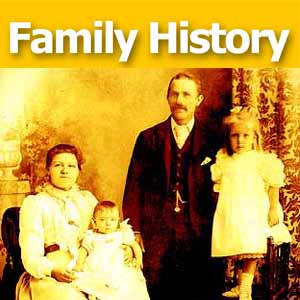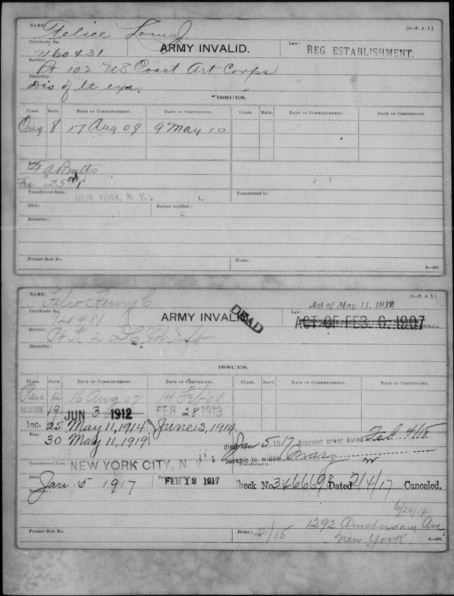by Lisa Cooke | Dec 3, 2013 | 01 What's New, Census, Family History Podcast
 Originally published Fall 2008
Originally published Fall 2008
Republished Dec. 3, 2013
[display_podcast]
Download the Show Notes for this Episode
Welcome to this step-by-step series for beginning genealogists—and more experienced ones who want to brush up or learn something new. I first ran this series in 2008. So many people have asked about it, I’m bringing it back in weekly segments.
Episode 9: Using Census Records
In this episode we start off by talking about a group of records critical to family history research in my home country: U.S. Federal Census Records. You’ll learn not only what to find in the regular schedules, but about the enumerators, the instructions they followed, and special sections like the economic census.
Then in our second segment we go straight to the source: Bill Maury, Chief of History Staff at the U.S. Census Bureau. I’ll be talking to him about the History section of the Census Department’s website. Note the updated Genealogy tab on the site, as well as the Through the Decades tab, which is packed with historical information for each census.
Updates
Since the show first aired, the 1940 U.S. Census has become publicly available. This was the largest, most comprehensive census taken, with over 132 million names of those known as the “greatest generation.” Full indexes and images are available at several sites. Your first stop should be the National Archives’ official 1940 census website to learn about the census itself. Then search it at your favorite genealogy data site in one of the links below.
Finally, I gave you specific instructions in the podcast on searching the 1930 U.S. Census online at Ancestry.com. To specifically search any of the U.S. censuses (or any other record collection) at Ancestry.com, go to the Search tab and select Card Catalog. You’ll see several censuses among the options they give you, or you can enter keywords like “1940 census.”
Links
Search U.S. censuses online at:
Ancestry.com
Archives.com
FamilySearch.org
findmypast.com
worldvitalrecords.com
OR Learn more about researching from microfilm at the National Archives website.
by Lisa Cooke | Dec 1, 2013 | 01 What's New, FamilySearch, Military, Records & databases
FamilySearch recently added another 192 million+ images and indexed records from North and South America and Europe to its growing FREE online collections. In the list at the bottom of this post you’ll find content from Brazil, Colombia, Peru, Spain, Switzerland, the United States, and Wales.
Notable collection updates include the 314,910 images from the Spain, Province of Barcelona, Municipal Records, 1387–1936,
collection, the 576,176 indexed records from the United States Veterans Administration Pension Payment Cards, 1907–1933, collection, and the 189,395,454

Sample image from “United States Veterans Administration Pension Payment Cards, 1907-1933.” Index and images. FamilySearch. https://familysearch.org : accessed 2013.
indexed records from the United States Public Records Index.
Here’s an example of a V.A. pension card, created by the Bureau of Pensions and Veterans Administration to record payments to veterans, widows and other dependents. FamilySearch describes the cards this way: “On the front of the cards for invalid veterans are recorded the name of veteran, his certificate number, his unit or arm of Service, the disability for which pensioned, the law or laws under which pensioned, the class of pension or certificate, the rate of pension, the effective date of pension, the date of the certificate, any fees paid, the name of the pension agency or group transferred from (if applicable), the date of death, the date the Bureau was notified, the former roll number, and ‘home.’ On the reverse side of the form appears the name of the veteran, his certificate number, and the record of the individual payments. The army and navy widow’s cards are similar to the invalids’ cards with the addition of the widow’s name and occasionally information regarding payments made to minors, but they do not indicate if the veteran had a disability.”
|
Collection
|
Indexed Records
|
Digital Images
|
Comments
|
| Brazil, Mato Grosso, Civil Registration, 1848-2013 |
0 |
126,870 |
Added images to an existing collection. |
| Brazil, Minas Gerais, Catholic Church Records, 1706-1999 |
0 |
827 |
Added images to an existing collection. |
| Brazil, Pernambuco, Civil Registration, 1804-2013 |
0 |
94,516 |
Added images to an existing collection. |
| Colombia, Catholic Church Records, 1600-2012 |
0 |
111,526 |
Added images to an existing collection. |
| Peru, Puno, Civil Registration, 1890-2005 |
0 |
176,918 |
Added images to an existing collection. |
| Spain, Province of Barcelona, Municipal Records, 1387-1936 |
0 |
314,910 |
Added images to an existing collection. |
| Switzerland, Fribourg, Census, 1839 |
0 |
2,552 |
New browsable image collection. |
| Switzerland, Fribourg, Census, 1842 |
0 |
2,851 |
New browsable image collection. |
| Switzerland, Fribourg, Census, 1845 |
0 |
3,062 |
New browsable image collection. |
| Switzerland, Fribourg, Census, 1850 |
0 |
2,968 |
New browsable image collection. |
| Switzerland, Fribourg, Census, 1860 |
0 |
20,530 |
New browsable image collection. |
| Switzerland, Fribourg, Census, 1870 |
0 |
22,554 |
New browsable image collection. |
| U.S., Alabama, County Marriages, 1809-1950 |
324,971 |
690,459 |
Added indexed records and images to an existing collection. |
| United States Public Records Index |
189,395,454 |
0 |
Added indexed records to an existing collection. |
| United States Veterans Administration Pension Payment Cards, 1907-1933 |
576,176 |
0 |
Added indexed records to an existing collection. |
| United States World War I Draft Registration Cards, 1917-1918 |
644,004 |
0 |
Added indexed records to an existing collection. |
| Wales, Court and Miscellaneous Records, 1542-1911 |
0 |
84,676 |
Added images to an existing collection. |
by | Jun 29, 2013 | Canadian, Census, Records & databases
 If you have Canadian kin, you’ll be pleased to hear that the 1825 census of Lower Canada is now searchable online, and the 1921 census will soon be available online, too!
If you have Canadian kin, you’ll be pleased to hear that the 1825 census of Lower Canada is now searchable online, and the 1921 census will soon be available online, too!
The 1825 census of Lower Canada counted nearly half a million people. Heads of household were actually named, with other members of the household counted by category. You can search by household name or geographic location.
The 1921 census counted 8.8 million people in thousands of communities across Canada. According to the Library and Archives Canada Blog, the population questionnaire had 35 questions. The census also collected data on “agriculture; animals, animal products, fruits not on farms; manufacturing and trading establishments; and [a] supplemental questionnaire for persons who were blind and deaf. This represents a total of 565 questions.” The census was released this past June 1 from the national Statistics office to the Library and Archives. That office is processing and scanning the nearly 200,000 images for public use. It hopes to have them posted soon.
Here’s a sample page from the 1921 census population schedule:

We think of Canada as a real melting pot today—or salad bowl, as they prefer. That wasn’t always the case. The 1825 census of Lower Canada counted mostly Europeans of French extraction. In 1901, 70% of Canadians claimed either British or French heritage. But in the first two decades of the 1900s, a huge immigration boom occurred that reached well beyond England and France. So the folks who show up on the 1921 census represented a newly multicultural Canada!
Start looking for your Canadian ancestors in the Library and Archives Canada’s popular Census Indexes, which include that 1825 census and a new version of the 1891 census, too. Watch the website for the 1921 census.
If your family arrived in Canada after the 1921 census, check out the website for The Canadian Museum of Immigration at Pier 21, where a million immigrants landed between 1928-1971.
by Lisa Cooke | Jun 18, 2013 | 01 What's New, Census, Records & databases
 Hands up, who wants to help prep the 1950 U.S. census for us all to explore?
Hands up, who wants to help prep the 1950 U.S. census for us all to explore?
The 1950 census won’t be released to the public for seven more years, but it took just longer than that to create the locational tools that millions of researchers have used to find their families on the 1940 census.
The dynamic duo of Steve Morse and Joel Weintraub, who produced the locational tools for the 1940 census on the Morse One-Step site, are recruiting 200+ volunteers to help transcribe enumeration district definitions and create urban area street indexes for the 1950 census.
Their “job description” for these volunteers sounds really meaty and hands-on: “These projects aren’t for everybody. Volunteers should have basic computer skills, typing skills, have access to the Internet, be detail people but not perfectionists, be independent workers and able to follow instructions, be patient enough to handle large amounts of information, and be comfortable with projects that may take weeks or months, not hours, to accomplish. You should be able to handle and manipulate images (jpgs) of maps and Enumeration District (ED) definition scans. A large computer monitor would be desirable but not essential. We will provide instructions for carrying out the work, and a place to ask questions. Volunteers may use some free programs to help speed up the entry process. We expect volunteers to make steady progress on their assignments, and we have the luxury of time right now to do it well.”
Learn more about the project here, and try the 1940 One-Step locational tools here.
by | Dec 26, 2012 | 01 What's New, Census

Genealogists in search of their family history have reaped great rewards from census records being digitized and made available online on websites like Ancestry.com.
In the future, Americans will have the option to respond to a ‘digital’ enumerator – the Internet.
According to CBS News “For the first time, the Census Bureau is giving U.S. households a chance to respond to government surveys over the Internet, part of a bid to save costs and boost sagging response rates in a digital age.”
Read the rest of the story here.
 Originally published Fall 2008
Originally published Fall 2008








